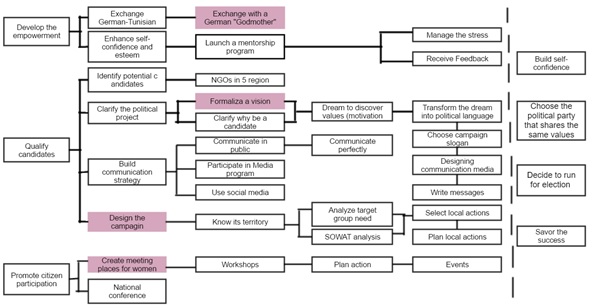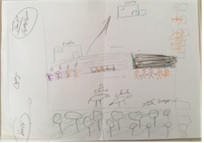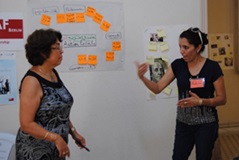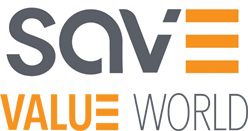By Dr. Bahia Bejar-Ghadhab
Introduction
The new Tunisian constitution dedicates women’s rights and its representation in the society became an innovative model for the Arab world in general. However, progress is still possible, especially by considering the gap between the legislation and the reality. Indeed, men admit the presence of women in politics but they refuse to assign decision-making positions. The European Academy for Women in Politics and Business (EAF Berlin) since 2012 implemented the project «Democracy needs women» in cooperation with the German Ministry of Foreign Affairs and the Ministry of Women’s Affairs, Family, Children and Elderly. This project, since 2015 has been supported by the German International Cooperation (GIZ) to promote the political participation of women.
Project: Democracy Needs Women
The project, targeted women activists in civil society both in Tunisia and Germany, administration and politics, is based on three areas: Exchange, Empowerment and Networking. The project focused in regions outside the capital Tunis, three regions located inside the country and two on the coast. Partners in the 5 chosen cities are NGO’s and they manage to establish a connection with women in general and rural women in particular.
Methodology
During the project, the methodology was combine value management tools, Creative symbolization, Neuro Linguistic Programming and Dynamic group. Functional analysis was used to construct the FAST diagram (fig.-1) that allowed establishing the different training and workshops. Three functions have been defined: develop the empowerment, qualify candidates and promote citizen participation. To achieve these functions, several solutions have been chosen (see fast diagram below).

Function: Develop the Empowerment
To develop the empowerment of women, two solutions were chosen: a mentoring program and an exchange with German godmothers.
Function: Qualify Candidates
To qualify candidate’s vision, communication and campaign design constitute the pillars of their training program. We used:
- Vision by value, dream and symbols
A workshop, using dream and symbols, has been organized in each region and allowed the participants to identify the needs in terms of functionality of the target population, discover important values and criteria, evaluate interests, skill and experience, formalize a vision that gathers all these values and criteria and represents the motivation of each candidate, and to choose a campaign slogan.
- Value management Campaign design
To design the election campaign, we used hypnosis and value management approaches. After the hypnosis session, the candidates are invited to represent their political campaign by a colored drawing as election campaign project representation (see fig-2 below).

After the creative symbolization session, value management approach enabled the candidates to put a framework for their campaign project. The systematic method allowed them to:
- Understand the district priorities in their city or region
- Express needs to satisfy target groups
- Gather information to make decision
- Evaluate all the expected economic effects from the project
- Define the scope and constraints of the project.
- Define the expected innovation level
- Know the objectives and resources of the Project
After putting the framework, the functional analysis allowed to define the functions requested by the stakeholders of the campaign.

The candidates took advantage of the functional analysis to adapt their message and speech considering the needs of the target population.
Function: Promote Citizen Participation
To achieve this function, we adopted a design to cost approach to build an action plan with a modest budget to seek low-resource activities and innovate. We assist our partners in organizing a workshop with a multidisciplinary group of 35 people. The group focused on realizing the functionality “Create meeting places for women” with a goal of reaching the largest number of women and especially in rural areas. Our partners succeeded in establishing an action plan with creative and sustainable ideas. They also succeeded to establish networks with multiple stakeholders.
Results
All partners are:
- Well connected with the municipality, administration and other associations,
- More professional in managing team, activity and events,
- More than 1000 people (98% women) took part of the different events in the five regions,
- In each region, more than 15 candidates, with high motivation for the next municipal elections, have been identified.
Women that participated in the project developed their skills and have improved their business, obtained promotions in their duties or became more involved in civil society and have even created new associations.
